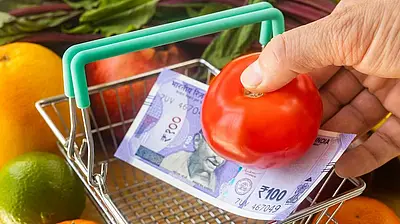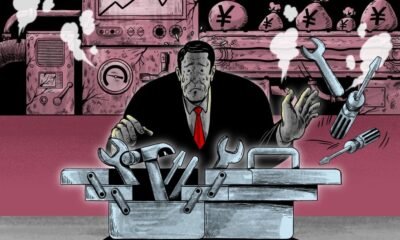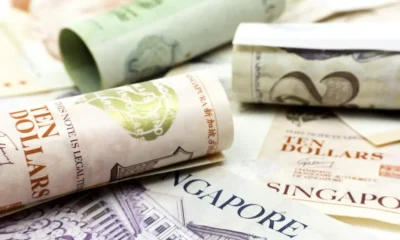Economy
Budget 2025. What’s FM’s Game Plan? Boost Growth, Cut Deficit, Or Finally Listen To The Struggling Middle Class?
Published
9 months agoon

The countdown to Budget 2025 has begun, and expectations are sky-high—especially from India’s middle class. But let’s be real: it’s a tough balancing act. The government has to juggle between keeping the fiscal deficit in check and pushing for economic growth. And if experts are to be believed, cutting the deficit might take priority over bold spending moves to boost Asia’s fifth-largest economy.
For the financial year ending March 2026, economists at UBS predict that the fiscal deficit target could be trimmed by 50 basis points to 4.4% of GDP, down from this year’s 4.9%. Meanwhile, a nominal GDP growth target of 10.5% is expected to be set for the next fiscal year.
Finance Minister Nirmala Sitharaman will present the budget on February 1, marking the first full-year budget of the coalition government that came to power in June. But it’s not exactly smooth sailing—India’s economy is slowing down, domestic demand is weak, the rupee is under pressure, and global uncertainties are rising.
What’s driving the slowdown? A mix of unseasonal rains, tighter fiscal policies, and sluggish credit growth as the RBI tries to rein in unsecured lending. With this backdrop, the budget is expected to put the spotlight on job creation in the manufacturing sector, rural housing programs, and measures to stabilize prices, according to Goldman Sachs.
Radhika Rao, senior economist at DBS, believes the government will focus on fine-tuning existing policies rather than announcing drastic new measures. However, there’s still hope for some relief—especially in the form of tax cuts.
Tax relief is reportedly high on the agenda, and while a cut in personal income tax rates or a higher standard deduction might not benefit everyone, some relief could be on the way. Middle-income households, in particular, might get a breather as the government looks at reducing tax burdens while continuing its big push for infrastructure—upgrading roads, railways, airports, and highways.
Deficit Takes Center Stage
After ballooning to 9.2% of GDP during the pandemic, India’s budget deficit has been on a steady decline—an essential move for securing a long-awaited credit rating upgrade.
Back in May, S&P Global Ratings gave India a confidence boost by upgrading its sovereign rating outlook from “stable” to “positive,” while keeping the actual credit rating at “BBB-”—the lowest investment grade. The reason? Strong economic growth and a government that seems committed to keeping its finances in check.
In her July budget speech, Finance Minister Nirmala Sitharaman promised to bring the deficit down to 4.9% this fiscal year and 4.5% next year. She stated – from 2026-27 onwards, our goal is to keep the fiscal deficit low enough so that central government debt remains on a downward path as a percentage of GDP.
So far, the government looks on track to keep the deficit below 5% this year—helped in part by a record $25 billion dividend from the RBI. But there’s another reason for the lower deficit: the government just isn’t spending as much. Nomura economists pointed out that capital expenditure has been “sharply underspent.”
Goldman Sachs crunched the numbers and found that over the last seven years, the government has consistently failed to fully use its allocated budget. On average, only about 80% of total available funds were actually spent. Post-pandemic, this gap narrowed a bit as extra subsidies were doled out to manage soaring food prices, but the overall trend of underspending remains.
Looking ahead, things could tighten even further. Goldman Sachs expects public spending to shrink to just 3.2% of GDP in 2025-26. That means less fuel for economic growth.
The investment bank noted, that the of rapid public capex expansion are behind, adding that the government has little room left to ramp up welfare spending.
Economic Slowdown. Can the Budget Help?
India, once the world’s fastest-growing major economy, is hitting a speed bump. After a weaker-than-expected GDP print for the September quarter—just 5.4%, the slowest in nearly two years—the government has been dialing down its growth forecasts.
The latest revision pegs full-year GDP growth at 6.4%, marking the slowest pace in four years. That’s a significant downgrade from the 7.2% projection in October, and it took three rounds of cuts to get here. Looking ahead, Nomura analysts expect the government to target 10.3% nominal GDP growth for the next fiscal year, slightly up from the 9.7% expected for FY25.
But if anyone is hoping for a big-bang stimulus package in Budget 2025, they might be in for disappointment. Shilan Shah, deputy chief emerging markets economist at Capital Economics, warns that while there could be some tax relief and spending boosts, they’ll likely be “piecemeal” rather than transformative.
The RBI’s Dilemma. To Cut or Not to Cut?
The Reserve Bank of India (RBI) has kept interest rates steady since February 2023. But with growth slowing faster than expected, pressure is mounting.
The problem? The rupee has been hitting record lows against the dollar. A rate cut could send inflation higher, put more pressure on the currency, and trigger capital outflows—none of which the RBI wants to deal with right now.
Inflation has eased slightly, staying within the RBI’s 6% tolerance range. It stood at 5.22% in December and 5.48% in November, giving the central bank some breathing room. UBS economist Tanvee Gupta Jain predicts a modest rate-cut cycle of about 75 basis points, starting in February.
Still, the RBI has signaled that monetary conditions could remain tight for a while longer, as it keeps an eye on inflationary risks.

The Trump Factor
Adding another layer of uncertainty? The return of Donald Trump to the White House.
Trump has floated the idea of universal tariffs, which could spell trouble for India’s trade surplus with the U.S.—currently at nearly $42 billion. A more protectionist U.S. trade policy could strengthen the dollar and push U.S. interest rates higher for longer.
For India’s policymakers, that’s a tough spot. If the RBI loosens policy to boost growth, it could widen the interest rate gap with the U.S., making Indian assets less attractive and pressuring the rupee even further.
Disinvestment. A Shrinking Target
One section of the budget that investors will be watching closely is the government’s disinvestment plans.
Turns out, the original target isn’t quite working out. India is reportedly slashing its disinvestment and asset monetization goal by 40%, bringing it down from ₹500 billion to less than ₹300 billion ($3.47 billion) for this financial year.
It’s not hard to see why—divestment proceeds have been sluggish. So far, the government has managed to collect only ₹90 billion, falling way short of the original ₹500 billion estimate, says UBS economist Tanvee Gupta Jain.
Looking ahead, she expects the government to set a more realistic disinvestment target of around ₹300 billion for the next fiscal year. While divestment has been a key focus area for raising funds, execution remains a challenge.
Will the Middle Class Finally Get a Break?
The Indian middle class has been playing a never-ending game of financial Tetris—trying to squeeze in rising expenses, loan EMIs, and daily essentials while their wages remain frustratingly stagnant. The government’s grand promises of growth sound great, but for the average salaried household, the reality feels very different – higher inflation, a big dent in savings, and the ever-growing burden of taxes and loans.
Salaries Stagnant, Expenses Skyrocketing
It’s no secret—pay raises haven’t kept pace with inflation. While corporate profits soar, salary hikes have been modest at best. Many professionals find themselves stuck at the same pay scale for years, while grocery bills, school fees, and utility costs climb relentlessly. The dream of moving up the economic ladder? It’s starting to feel more like a myth.
Savings Have Taken a Hit
Not too long ago, the middle class prided itself on saving for the future. But post-pandemic, savings rates have hit a two-decade low. Higher costs mean families are dipping into their savings just to get by. Fixed deposits? Many have broken them early. Investments? That’s now a luxury. Retirement planning? Pushed to the back burner.
The EMI Trap
Owning a home, once a middle-class aspiration, is now a financial tightrope. With rising interest rates, home loans have become significantly costlier. Add to that education loans, car loans, and personal loans—many households are juggling multiple EMIs with little room to breathe. It’s not about thriving anymore; it’s about surviving.

Inflation. The Silent Killer
Even with inflation technically “cooling” on paper, the ground reality is starkly different. Essentials like vegetables, milk, and cooking gas have all seen sharp hikes. The middle class doesn’t get subsidies like the poor, nor do they have the financial cushioning of the rich. They’re stuck in between, feeling the full impact of every price rise.
What the Middle Class Wants From Budget 2025
With so much pressure, expectations from the budget are high, so what are the expectations?
- Tax Relief – Whether it’s a hike in the standard deduction, lower income tax rates, or better exemptions, some breathing room is desperately needed.
- Lower GST on Essentials – A cut in GST on everyday necessities would ease the monthly budget crunch.
- Affordable Housing Support – Cheaper home loans and better incentives for first-time buyers could reignite hopes of homeownership.
- Savings Incentives – Higher tax exemptions on savings schemes and better returns on small savings instruments like PPF and FDs.
- Job Creation & Wage Growth – More investments in sectors that create stable, well-paying jobs rather than just boosting corporate earnings.
The Last Bit. Will the Budget Deliver?
The finance minister has a tough balancing act—cutting the fiscal deficit while keeping the economy growing. But if the middle class continues to feel the squeeze, consumer demand will weaken further, hurting the very economic growth the government is trying to boost.
In short, the upcoming budget and monetary policy decisions will need to be carefully calibrated. Balancing growth, inflation, and global risks is going to be a tricky act. Fiscal discipline might be necessary, but it’s also likely to slow down growth.
Questions – Will Budget 2025 finally acknowledge the struggles of India’s middle class, or will they be left once again to fend for themselves or will fiscal discipline take precedence? We’ll find out soon enough!
You may like
-


Taiwan’s ‘Historic’ TSMC Deal, A Win Or The End Of Its ‘Silicon Shield’ As China Threatens? A Jittery Taiwan Watches Trump’s Moves On Ukraine, Wondering, Could We Be Next?
-


America And China’s Thirst For Gold In 2025 Is Draining Other Countries’ Reserves; Here’s Why?
-


China To Cut Inflation Outlook To 20-Year Low, Eyes Fresh Stimulus At ‘Two Sessions’ To Boost Economy
-


Trump’s Latest Tariff Move on Mexico and Canada. Import Taxes Back on Track Hinting At A Full Blown Trade War!
-
India Cuts Tariffs On US Bourbon! But Do Trump’s Retaliatory Tariffs Mean Cheaper American Goods For Indian Consumers?
-


Singapore Economy On A High. Annual GDP Expands At Fastest Pace Since 2021. Asian Markets Mixed Bag Reaction To Trump’s Reciprocal Tariffs

